Social Welfare
Higher Education under NEP 2020: Reimagining India’s Academic Landscape
Posted On:
29 JUL 2025 10:43AM
|
Key Takeaways
|
- The Vidya Lakshmi Scheme (2024) sanctioned ₹2,358 crore in loans, supporting 8,379 students via a digital, collateral-free platform across 860 premier institutions.
- New Indian campuses of IITs set up in Zanzibar, Abu Dhabi, and Dubai, while foreign universities like Deakin and Wollongong, and Southampton have set up campuses in India.
- SWAYAM saw 5.15 crore+ enrolments; Virtual Labs developed 900+ labs; NDLI hosts 8 crore+ resources—scaling access, credit transfer, and multilingual learning nationwide.
- PM-USHA granted Rs. 100 crore each to 35 universities to strengthen autonomy, digital infra,
and global linkages, aligned with NEP 2020’s vision for quality enhancement.
|
A New Horizon for Indian Education
The National Education Policy (NEP) 2020 stands as a defining moment in India’s journey towards revitalising its higher education landscape. Marking a comprehensive overhaul of the education system, the NEP 2020 is a visionary blueprint aimed at repositioning India among the leading higher education hubs of the world.
Anchored in the guiding principles of access, equity, quality, affordability, and accountability, NEP 2020 seeks to redefine both the structure and substance of education. While the school education reforms focus on foundational learning, curriculum renewal, assessment transformation, and holistic development, the higher education agenda lays emphasis on flexible multidisciplinary learning, institutional autonomy, quality research, and global integration.
For higher education in particular, the policy proposes a systemic shift from rigid silos to flexible, learner-centric models; from content-heavy instruction to critical thinking and research; and from fragmented regulation to a streamlined, empowered governance architecture.
|
Overview of National Education Policy
|
- Approved on 29 July 2020 – first education policy to be launched in 34 years
- Prepared after 5 years of thorough consultation from experts and 2 lakh + suggestions
|
|
Vision and Objective
|
|
Build a holistic, learner centric, multidisciplinary education system
Align with 21st century needs while rooted in Indian heritage Promote economic growth, social equity, and nation building
|
|
Higher Education Reforms
|
- Target 50% GER by 2035
- Establish Multidisciplinary Education & Research Universities and National Research Foundation
- Launch Academic Bank of Credits, National Credit Framework and options for Multiple Entry and Exit for flexible and lifelong learning
- Break disciplinary silos and integrate Indian Knowledge Systems
Unified regulation, teacher development, tech-driven delivery
|
Enhancing Access, Equity, and Inclusion
NEP 2020 aims to achieve a GER of 50 % by the year 2035. To achieve this the government is focusing on setting up more higher education institutions, provide support to disadvantaged students, making standalone institutions multidisciplinary and promoting distance and online learning.
Data as per AISHE over the period 2014-15 to 2021-22
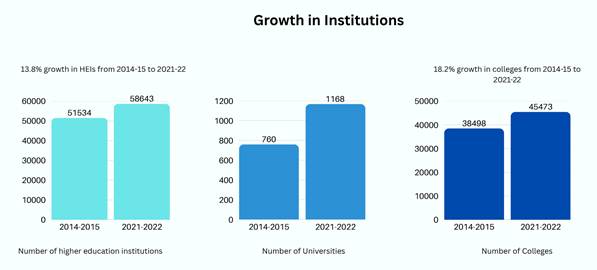
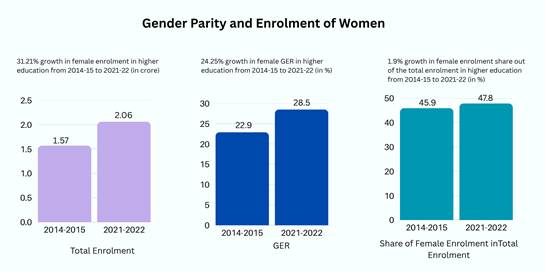
Growth Trend as per Social Categories
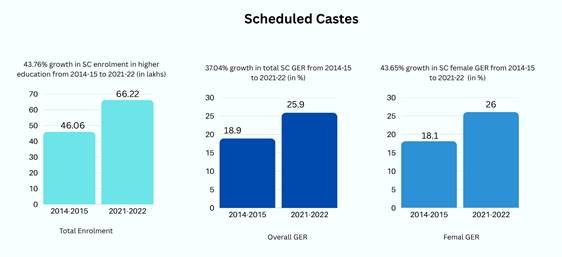
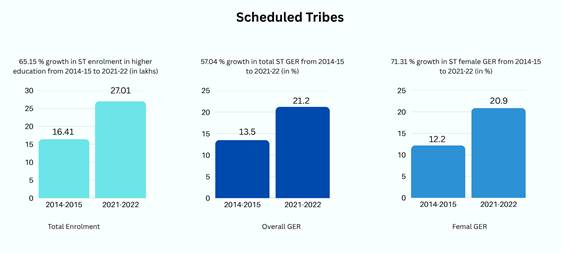
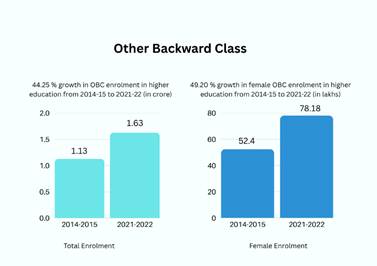
Initiatives to enhance Inclusivity
The PM VidyaLakshmi Scheme, launched in November 2024, aims to enhance access to higher education through collateral-free loans for students enrolled in India’s top 860 institutions. With a budget of ₹3,600 crore from FY 2024–25 to 2030–31, it is set to benefit over 22 lakh students annually and support an additional 7 lakh students, with a focus on inclusivity.
Key features include:
- Collateral-free loans up to ₹7.5 lakh, backed by a 75% credit guarantee
- 3% interest subvention on loans up to ₹10 lakh for students from families earning below ₹8 lakh per annum, not covered under other schemes
- Fully digital platform for application, approval, and repayment
- Secure disbursement via e-vouchers and CBDC wallets
|
Vidya Lakshmi Scheme: Financial Access for Students
Launched in November 2024, the scheme offers collateral-free education loans to students in 860 top institutions, benefiting over 22 lakh students annually.
Supports tuition fees and academic expenses, with a total outlay of ₹3,600 crore (FY 2024–25 to 2030–31)—aiming to assist 7 lakh additional students.
Key benefits:
- Loans up to ₹7.5 lakh with 75% credit guarantee.
- 3% interest subvention on loans up to ₹10 lakh for families earning below ₹8 lakh per annum, if not covered under other government schemes.
Delivered via a fully digital, transparent platform with e-vouchers and CBDC wallets for smooth disbursals and repayments.
Progress so far:
- Applications received: 30,890
- Loans sanctioned: 13,358 (₹2,357.6 crore)
- Loans disbursed: 8,379 (₹320.5 crore)
|
VidyaLakshmi Digital Rupee App allows direct access to interest subvention benefits and is integrated with 61 banks, developed in partnership with DFS, IBA, and member banks.
Support for the Divyangjans : To ensure meaningful participation of persons with disabilities and mental illness in higher education, efforts are being made to through guidelines on inclusive pedagogical practices. These focus on adapting teaching methods and learning environments to meet diverse needs and foster equitable academic engagement. The guidelines list following key pedagogical components:
- Learning Support
- Assistive devices
- Curriculum design
- Assessment and Evaluation
- Personalized support and counselling integration
Standalone institutions becoming inclusive multi-disciplinary centres : NEP 2020 envisions a shift from rigid and fragmented higher education structures to flexible, multidisciplinary, and globally aligned institutions that promote equity, inclusion, and innovation. It introduces a four-year undergraduate programme with multiple exit options and credit portability via the Academic Bank of Credit (ABC). Curricula now follow a Choice-Based Credit System (CBCS), enabling interdisciplinary combinations and nurturing critical thinking and ethical reasoning.
All Higher Education Institutions (HEIs) are to transition into multidisciplinary universities or degree-granting colleges by 2040, with at least one major HEI in every district by 2030. Flagship Multidisciplinary Education and Research Universities (MERUs) are being set up under PM-USHA, with ₹100 crore allocated to each of 35 select institutions to implement key reforms in research, digital infrastructure, internationalization, and inclusion.
Institutions will also be reclassified as Research-Intensive Universities, Teaching-Intensive Universities, or Autonomous Degree-Granting Colleges. This graded autonomy, based on transparent performance metrics, will gradually replace the affiliating college model—enhancing institutional quality and accountability.
Promoting Online and Distance Learning
In accordance with the UGC (Open & Distance Learning and Online Programmes) Regulations, 116 HEIs offer 1,149 Open & Distance Learning programmes, and 102 HEIs offer 544 online programmes, benefiting over 19 lakh students.
As per UGC’s Credit Framework for Online Courses students can now transfer upto 40 % credits from SWAYAM MOOCs towards completion of their programmes, promoting flexibility, lifelong learning, and enabling HEIs to offer multidisciplinary options.
The National Digital University (NDU), envisioned in the National Education Policy (NEP) 2020, marks a significant advancement in India’s higher education system. It is designed to broaden access to high-quality education, foster lifelong learning, and equip students with industry-relevant skills through a flexible, inclusive, and technology-enabled framework.
Multidisciplinary and Flexible Higher Education
The National Education Policy (NEP) 2020 envisions a transformative shift in Indian higher education, promoting a learner-centric, flexible, and multidisciplinary ecosystem. This vision is being realized through a series of structural reforms and digital innovations:
Key Initiatives
|
National Credit Framework (NCrF): Launched on April 10, 2023, NCrF enables credit accumulation from academic, vocational, and experiential learning. Adopted by 170 universities, it supports lifelong learning and smooth transitions across disciplines.
|
|
National Higher Education Qualification Framework (NHEQF): Released on May 11, 2023, NHEQF defines learning outcomes from undergraduate to doctoral levels, ensuring national and international equivalence and mobility.
|
|
Curriculum and Credit Framework for Undergraduate Programs: Introduced on December 12, 2022, this framework incorporates a choice-based credit system, multiple entry/exit options, and interdisciplinary learning pathways.
|
|
Apprenticeship/Internship Embedded Degree Programs: Over 100 institutions now offer programs integrating industry experience, with at least 20% credits dedicated to internships/apprenticeships.
|
|
SWAYAM Plus: This platform offers industry-aligned courses in emerging fields like AI and Data Analytics. The details of the same are provided in later sections
|
|
National Apprenticeship Training Scheme (NATS 2.0): Disbursed Rs. 489 crore in stipends through
12.12 lakh DBT transactions, democratizing access to on-the-job training.
|
These initiatives collectively support a future-ready education system, aligned with global standards and responsive to evolving industry needs.
Multiple Entry and Exit (MEME)
The Multiple Entry and Exit (MEME) framework, a cornerstone of NEP 2020, to promote academic flexibility and reduce dropout rates. It empowers students to pause and resume education based on personal and professional needs, enhancing the Gross Enrolment Ratio (GER) and supporting lifelong learning.
- 153 universities offer multiple entry options, benefiting 31,156 UG and 5,583 PG students.
- 74 universities have implemented multiple exit pathways, aiding 25,595 UG and 2,494 PG students.
- 97 Centrally Funded Institutions (CFIs) have adopted MEME, with 33% of their courses offering MEME provisions.
Academic Bank of Credit (ABC)
The Academic Bank of Credits (ABC), facilitates academic mobility through a structured credit transfer mechanism, allowing students to pursue courses across multiple higher education institutions and accumulate credits towards a degree or diploma. It functions as a digital repository where academic credits earned by students are securely stored and easily accessible. This system promotes flexibility in learning and supports multidisciplinary education. Additionally, ABC enables the seamless integration of skills, knowledge, and learning experiences into a unified credit- based framework, empowering students with greater autonomy in shaping their academic journeys.
Biannual Admissions in HEIs
University Grants Commission (UGC) has approved Biannual Admissions according to which university admissions will now be done in two cycles: July/August and January/February. This reform replaces the traditional single-cycle model and aligns with NEP 2020’s goal of achieving 50% GER by 2035. It enhances student choice, institutional efficiency, and internationalization of Indian higher education.
National Credit Framework (NCrF)
Developed collaboratively by regulators of school, skill, and higher education, and operationalized through a Standard Operating Procedure (SOP) issued on August 7, 2024, NCrF offers a unified structure for credit accumulation, transfer, and redemption across School education, Higher education, Vocational training, Skill development, Work-based learning. It is embedded within the Curriculum and Credit Framework for Undergraduate Programs (CCFUP). It supports multiple entry and exit options, lifelong learning, and recognition of prior learning and facilitates interdisciplinary mobility and industry-aligned skilling.
Curriculum and Credit Framework for Undergraduate Programs (CCFUP)
Introduced by the UGC in December 2022, the CCFUP reimagines undergraduate education. Its key features include Multiple Exit Options with Certificate after 1 year, Diploma after 2 years and Bachelor’s degree after 3 or 4 years. It enables transitions across Institutions, disciplines, learning modes (ofline, online, hybrid). Credits are tracked via the Academic Bank of Credit (ABC) and aligned with NCrF. It encourages interdisciplinary exploration, allowing students to pursue courses across arts, sciences, humanities, and vocational streams.
Dual Degrees
In a move to expand academic flexibility, the University Grants Commission (UGC) issued guidelines on permitting students to pursue two academic programmes simultaneously. The permissible combinations include: two full-time degree programmes (provided their class timings do not overlap), one full-time programme along with one online or distance learning programme, or two programmes through online or distance mode. This initiative aligns with NEP 2020’s vision of promoting multidisciplinary and flexible learning pathways.
National Higher Education Qualification Framework (NHEQF)
Key reform under NEP 2020 aimed at standardizing and enhancing the quality of higher education in India. It provides a structured framework for the development, classification, and recognition of qualifications from Level 4.5 (first-year undergraduate) to Level 8 (doctoral programs).
Key Features and Benefits:
- Defines graduate attributes through clearly articulated learning outcomes, helping students, parents, institutions, and employers understand the level and nature of academic achievements.
- Facilitates national and international equivalence and comparability of qualifications, supporting student mobility across institutions and countries.
- Promotes interdisciplinary and inter-institutional pathways, enabling learners to transition smoothly between disciplines and institutions.
- Supports lifelong learning by recognizing prior learning and enabling flexible academic progression.
- Enhances transparency and coherence in academic standards, thereby building public trust in India’s higher education system.
- By aligning qualifications with global benchmarks and learner -centric outcomes, the NHEQF strengthens India’s position in the global education landscape
Technology and Digital Learning
Under the National Education Policy (NEP) 2020, India is harnessing the power of digital innovation to expand access, enhance quality, and modernize higher education. A range of technology-driven initiatives—from online learning platforms to virtual labs and AI-powered tools—are transforming how students learn, upskill, and connect with real-world opportunities across the country.
- SWAYAM: India’s national MOOC platform with over 5.15 crore enrolments, 16,530+ courses, and 388 universities permitting up to 40% credit transfer.
- SWAYAM Plus: Launched in February 2024, it offers industry-integrated online courses in fields like AI, Data Analytics, and Healthcare, forming the base of the Digital University.
- Virtual Labs: Offers 900+ virtual labs and 1,200+ experiments across STEM subjects to provide hands-on learning experiences.
- National Digital Library (NDLI): Hosts a vast collection of 8 crore+ digital academic resources in video, text, and audio formats.
- Anuvadini & e-KUMBH: AICTE’s Anuvadini supports 22 languages for translation; e-KUMBH offers engineering books in multiple Indian languages.
- APAAR ID: A unique 12-digit academic ID seeded for 2.36 crore+ students, enabling seamless credit transfer, DigiLocker integration, and lifelong learning.
- NETF (National Educational Technology Forum): Established under AICTE to promote open exchange of ideas on the use of technology in education.
- NEAT (National Educational Alliance for Technology): Lists 393 EdTech firms with 171 products; 25% free coupons are allocated for EWS students, benefiting over 1.15 lakh learners.
- Internship Portal: A single platform with 11,578 HEIs and 78,759 industries, offering 54 lakh+ internships nationwide.
- IDEA Labs: IDEA Labs: AICTE-IDEA (Idea Development, Evaluation & Application) Labs has been set up in the technical institutions promoting multidisciplinary education & research, strong societal and industry linkage, support the new age learning and encouraging STEM experiential learning. 423 IDEA labs have been set up in HEIs.
Centers of Excellence and Institutional Development
Establishment of 42 new Central Institutions
Since 2014, 42 new Central Higher Educational Institutions have been established, including Central Universities, IITs, IIMs, NITs, IIITs, and IISERs, reflecting a strong push towards academic excellence and regional development.
Institution-wise additions:
- Central Universities: 8 new (from 40 to 48)
- IITs: 7 new (from 16 to 23)
- IIMs: 8 new (from 13 to 21)
- NITs & IIEST: 1 new (from 31 to 32)
- IIITs: 16 new (from 9 to 25)
- IISERs & IISc: 2 new (from 6 to 8)
Total institutions increased from 115 to 157
Ladakh has got its first ever Central University by the name, Sindhu Central University. The university has launched 4 post-graduate programs – M. Tech Atmospheric and Climate Sciences, MTech Energy Technology and Policy, M.A Public Policy and M.A. Buddhist Sciences.
Center of Excellence in Artificial Intelligence
For realizing the vision of "Make AI in India and Make Al work for India", government has approved establishment of three Centers of Excellence (CoE) in Artificial Intelligence (AI) namely CoE in Health in IISc, COE in Sustainable Cities in IIT Kanpur and CoE in Agriculture in IIT Ropar with a total financial outlay of Rs. 990.00 Cr over the period of FY 2023-24 to FY 2027-28. Further, a new COE in Education with an outlay of Rs.500 crores was announced in the budget for FY 2025 - 26.
12 Institutions of Eminence (8 public, 4 private)
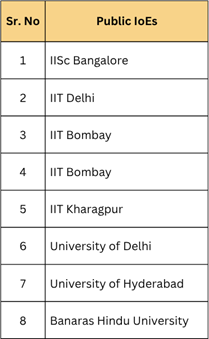
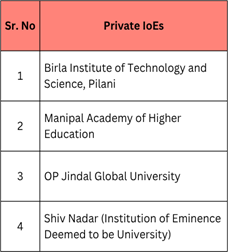
The initiative aims to establish a framework for identifying and supporting higher education institutions with the potential to evolve into world-class centers of teaching and research. Under this effort, 12 Institutions of Eminence (IoEs) have been recognized.
Central Sanskrit Universities established
- The Central Sanskrit Universities Act, 2020 redefined three prominent Sanskrit institutions to the status of Central Sanskrit Universities.
- Rashtriya Sanskrit Sansthan, New Delhi – Established in 1970, it previously held the status of a deemed university.
- Shri Lal Bahadur Shastri Rashtriya Sanskrit Vidyapeeth, New Delhi – Founded in 1962, it was also a deemed university.
- Rashtriya Sanskrit Vidyapeeth, Tirupati – Established in 1962, this institution too was a deemed university.
Quality Assurance and Accreditation
As envisioned in the National Education Policy (NEP) 2020, a transformative overhaul of the regulatory and accreditation landscape is underway to ensure transparency, autonomy, and performance-driven governance. At the centre of this reform is the proposed Higher Education Commission of India (HECI), aimed at enhancing accountability, ensuring institutional autonomy, and fostering innovation through clear role delineation and reduced conflicts of interest.
- Integrated Regulation through HECI:
To eliminate overlapping oversight and streamline regulation, NEP 2020 proposes the creation of the Higher Education Commission of India (HECI)—a single, overarching body. Replacing multiple regulators, HECI will implement a “light but tight” framework that ensures institutions are empowered while being held accountable.
- Graded Autonomy Linked to Performance:
Institutions performing well in accreditation and rankings are now eligible for graded autonomy, allowing them to independently launch new programmes, form international collaborations, and manage finances. This shift has been institutionalised through the UGC Autonomous Colleges Regulations (2023) and the Deemed University Regulations (2023).
- Outcome-Oriented Accreditation:
The NAAC accreditation framework has been revamped to prioritise outcome metrics such as employability, research impact, and community engagement. Accreditation now determines autonomy and funding eligibility, with models like Maturity-Based Graded Levels (MBGL) and binary accreditation being introduced.
- NIRF 2.0 and Rankings-Linked Funding:
The National Institutional Ranking Framework (NIRF) has evolved into NIRF 2.0, aligning closely with NEP priorities. It now includes parameters like digital access, innovation, and social inclusion. Rankings are directly linked to funding allocation under schemes such as PM-USHA and Institutions of Eminence (IoEs), strengthening the link between performance and public investment.
Research, Innovation, and Technology
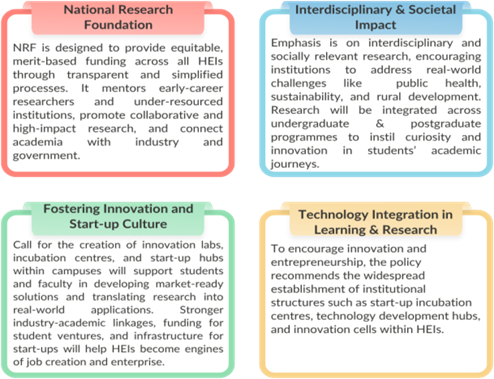
NEP 2020 envisions a knowledge-driven higher education system that places research, innovation, and technology at its core. It aims to create a vibrant ecosystem that empowers institutions to contribute meaningfully to national and global development.
India’s aspiration to become a USD 35 trillion economy by 2047 is intricately linked to its expanding research and innovation landscape. The National Education Policy (NEP) 2020 recognizes that the global knowledge landscape is undergoing rapid transformation, particularly in science and
technology, artificial intelligence (AI), and machine learning (ML), presenting both opportunities and challenges for India. there is a need of synergizing efforts further to truly enable a robust research ecosystem that permeates across universities. At present India invests only 0.64% of GDP in research, compared to 3.47% in the USA, 5.71% in Israel, and 2.41% in China (2023-24).
In alignment with NEP 2020, the Government of India has taken several initiatives to strengthen R&D landscape in the country. These include Anusandhan National Research Foundation; Industry-Academia Linkages in HEIs; Startup Ecosystem in HEIs across India; Innovation Cells and Hackathons; Cross-disciplinary Faculty Development in AI, IKS, Tech
Anusandhan National Research Foundation:
The Anusandhan National Research Foundation (NRF), established under the 2023 Act, is a key NEP 2020 initiative to build a robust, inclusive research ecosystem with a ₹50,000 crore hybrid funding model. It supports peer-reviewed grants, infrastructure, mentorship, and research in regional
languages while strengthening R&D through over 2,500 HEIs and 300 universities with active R&D cells, innovation hubs and industry academia linkeages.
Reforms such as the Ph.D. Degree Regulations 2022 promote flexible and inclusive research pathways. Ph.D. enrolment has doubled to 2.34 lakh by 2022–23, with female enrolment rising by 135.6%. India ranked 3rd globally in research publications in 2024, with output rising 142% since 2015.
Innovation has surged—patent filings reached 92,168 in 2023–24, with HEIs contributing 25% of these. The KAPILA programme advanced IP literacy with over 10,800 patents filed and 71,000+ faculty/students trained.
The NIRF India Rankings 2024 introduced a dedicated Research and Innovation Index, reflecting growing institutional competitiveness. Under the Institutions of Eminence scheme, 12 HEIs are driving industry-linked R&D, tech transfer, and start-up incubation—firmly positioning India on the global research map.
Startup Ecosystem in HEIs across India
Aligned with the vision of NEP 2020, the Government of India is strengthening the innovation and startup ecosystem within Higher Education Institutions (HEIs) through the establishment of Institution’s Innovation Councils (IICs). These councils promote applied research, ideation, and entrepreneurship by offering platforms for prototype development, incubation, and industry collaboration. To date, 16,051 IICs have been set up across 28 States and 8 Union Territories, driving innovation through mentorship, hackathons, and innovation challenges—positioning HEIs as catalysts in India’s journey towards becoming a global innovation hub.
Cross-disciplinary Faculty Development in AI, IKS, Tech
Aligned with NEP 2020, the Malaviya Mission Teacher Training Programme (MMTTP) has trained
2.5 lakh faculty through 3,957 programmes across 144 centres, with focus on AI, cybersecurity, STEM, and leadership.
The Indian Knowledge Systems (IKS) initiative has set up 51 centres, launched 38 interdisciplinary courses, and initiated 88 research projects, alongside 5,527 internships and training for 1,000 faculty, with a goal to train 10,000 more.
Additionally, UGC issued guidelines on 14.03.2022 for establishing Research and Development Cells (RDCs) in HEIs to foster multidisciplinary and translational research, aligning with Atma-Nirbhar Bharat goals. As of now, RDCs have been set up in around 2,871 Universities/HEIs.
AICTE has established 423 IDEA (Idea Development, Evaluation & Application) Labs in technical institutions to promote multidisciplinary education, STEM-based experiential learning, and strong academia-industry linkages
Bhartiya Bhasha and Indian Knowledge Systems
The Government of India has prioritized the promotion of Bhartiya Bhasha (Indian languages) and the integration of Indian Knowledge Systems (IKS) into mainstream education. These initiatives aim to preserve and propagate India’s rich linguistic and intellectual heritage while fostering inclusive and
multilingual learning environments. Through curriculum reforms, digital platforms, and institutional support, NEP 2020 encourages the use of Indian languages in teaching, research, and assessment, and mandates credit-based courses in IKS across higher education institutions.
Multilingualism in Education:
- Anuvadini App & e-KUMBH Portal: AICTE’s Anuvadini App facilitates translation of engineering, medical, law, UG, PG, and skill books into Indian languages; these are accessible via the e-KUMBH portal.
- Multilingual Content on SWAYAM: Study materials are made available in multiple Indian languages on the SWAYAM platform to support diverse learners.
- CSTT Terminology Compilation: The Commission for Scientific and Technical Terminology (CSTT) has compiled over 30 lakh scientific and technical terms in 22 Indian languages, with 16 lakh terms digitized.
- ASMITA Initiative: Aims to produce 22,000 books in 5 years across 22 languages, supporting academic translation and original writing.
- Regional Language Education in Engineering: 41 engineering institutes across 10 states permitted to offer education in 12 regional languages, promoting technical education in mother tongues.
- Multilingual National Exams: CUET, JEE (Mains), and NEET (UG) are conducted in 12 Indian languages, enhancing access and fairness in national-level entrance tests.
Internationalization of Higher Education
NEP 2020 aims to position India as a global hub for higher education by promoting collaborative research and academics, two way international student mobility, internationalization at home by setting up global standards and best practices in Indian institutions, foreign university presence, and Indian HEIs’ presence abroad.
International Campuses of Indian Universities
|
As part of its global outreach, India has begun establishing international campuses of its premier higher education institutions. These initiatives aim to position India as a global knowledge hub and expand access to quality education worldwide9.
- IIT Madras–Zanzibar: MoU signed on 5 July 2023; campus established in Zanzibar, Tanzania with classes commenced under partnership between MoE (India) and MoEVT (Zanzibar).
- IIT Delhi–Abu Dhabi: MoU signed on 15 July 2023 with Abu Dhabi Department of Education and Knowledge (ADEK); campus is operational and marks IIT Delhi’s first international presence.
- IIM Ahmedabad–Dubai: MoU signed on 8 April 2025 with UAE Government for establishing the IIMA Dubai Campus in Dubai International Academic City; will offer full-time MBA and executive education programmes.
|
Foreign Universities in India
Prestigious institutions like Deakin and Wollongong Universities (Australia) have launched campuses in GIFT City, Gujarat, and the University of Southampton (UK) has set up in Gurugram marking a new era of global academic presence in India. Six universities from UK, Australia, USA and Italy have been given LoA for setting up their campuses in India
|
Deakin University, Australia
Campus established in Gift City, Gujarat
|
University of Wollongong, Australia
Campus established in Gift City, Gujarat
|
University of Southampton, UK
Campus established in Gurugram
|
Study in India Programme Same status and style as MEME
The Study in India campaign has expanded India's appeal as a global education destination. Since its launch, total Enrolment has been 47,602 international students from Asian and African countries. To attract international students, the Study in India5 campaign has been revamped with a dedicated portal launched in 2023, offering 8,000+ programs from over 600 accredited institutions and reaching 136+ countries. Indian HEIs have also established International Student Offices for enrolment, support, and integration.
Regulations for Joint / Dual / Twinning Degrees Same status and style as MEME
To promote academic and research excellence through global engagement, the University Grants Commission (UGC) issued the Regulations on Academic Collaboration between Indian and Foreign Higher Educational Institutions on 2 May 2022. These regulations enable Indian institutions to offer Twinning, Joint Degree, and Dual Degree programmes in collaboration with reputed foreign universities. The initiative aims to provide international exposure, promote internationalisation at home, and deliver multidisciplinary education through globally relevant curricula—all while enhancing student employability and improving India’s position in global university rankings.
Key Highlights:
- Encourages student and faculty mobility, collaborative research, and curriculum integration.
- Enhances the global standing of Indian HEIs by aligning with international ranking parameters.
- Aims to attract foreign students to Indian campuses.
Current Status:
Out of 230 eligible Indian universities, 103 HEIs are currently offering collaborative academic programmes with foreign institutions.
Global Initiative of Academic Network (GIAN) and Scheme for Promotion of Academic and Research Collaboration (SPARC)
Flagship initiatives like GIAN and SPARC support academic and research collaboration. Scheme for Promotion of Academic and Research Collaboration (SPARC), a flagship initiative of the Ministry of Education, fosters international research partnerships by enabling top Indian Higher Educational Institutions (HEIs)—including those ranked in the top 100 under NIRF, Central Universities, and Institutes of National Importance—to collaborate with leading foreign universities ranked within the top 800 in QS rankings from 28 selected countries. To streamline access, the SPARC Portal has been relaunched, now accepting proposals year-round at sparc.iitkgp.ac.in, where detailed guidelines and submission formats are available. As of now, 799 joint research projects worth ₹515.99 crore have been sanctioned, with 392 completed and others in various stages of implementation. The programme has yielded 51 patent filings, out of which 22 patents have been granted. SPARC supports collaboration under 12 strategic themes, including Advanced Materials, Semiconductors, Healthcare & MedTech, Energy & Climate Change, Blue Economy, Space & Defence, Smart Cities & Mobility, Manufacturing & Industry 4.0, and more.
Indian institutions in QS 2025 World Rankings and Subject Rankings
India continues to strengthen its global academic presence, emerging as the most represented higher education system in the QS World University- Asia Rankings 2025, with 163 Indian universities out of the 987 institutions featured. Notably, seven Indian institutions rank among the top 100 Asian universities, including five Indian Institutes of Technology (IIT Delhi, Bombay, Madras, Kharagpur, and Kanpur), the University of Delhi, and the Indian Institute of Science (IISc).
In the QS World University Subject Rankings 2025, a total of 79 Indian Higher Educational Institutions (HEIs) have been included—marking a growth from 69 in the previous year. This 18.7% increase has positioned India as the second most represented country in Asia, with 66 Indian universities featured across various disciplines.
Additionally, 10 Indian HEIs have secured positions in the top 50 globally in specific subject areas. These include six IITs, two Indian Institutes of Management (IIMs), one Central University, and one Deemed University—reflecting India’s growing academic competitiveness on the global stage.
Financing and Budgetary Expansion
Higher Education Financing Agency (HEFA) Same status and style as MEME,
To strengthen academic infrastructure and promote financial autonomy among Higher Education Institutions (HEIs), the Higher Education Financing Agency (HEFA) was established in 2017. It operates on a loan-based model, enabling institutions to access capital without upfront budgetary support. Over seven years, HEFA has sanctioned ₹44,449.18 crore for 201 projects, benefiting premier institutions such as IITs, IIMs, NITs, and Central Universities. These funds have been used to upgrade laboratories, hostels, classrooms, and research infrastructure, supporting the development of world- class academic facilities.
PM-USHA (Prime Minister Uchchatar Shiksha Abhiyan)
Complementing this effort, the PM-USHA (Prime Minister Uchchatar Shiksha Abhiyan) scheme was launched under the NEP 2020 framework to transform select public universities into Multidisciplinary Education and Research Universities (MERUs).
|
PM-USHA: Strengthening Institutional Capacity
The Pradhan Mantri Uchchatar Shiksha Abhiyan (PM-USHA) is the flagship centrally sponsored scheme for higher education reform. It supports the transformation of state universities and colleges by providing funding tied to performance-based outcomes. The scheme has been instrumental in:
- Promoting digital infrastructure, internationalization, and academic autonomy
- Advancing equity and inclusion through targeted interventions in underserved regions.
|
Click here to see PDF
RT/RK
(Backgrounder ID: 154950)
आगंतुक पटल : 12460
Provide suggestions / comments